You can hardly follow any media without finding some article about the latest whizzbang electric propulsion multicopter project that “will transform urban transportation!” Or so they breathlessly exclaim.
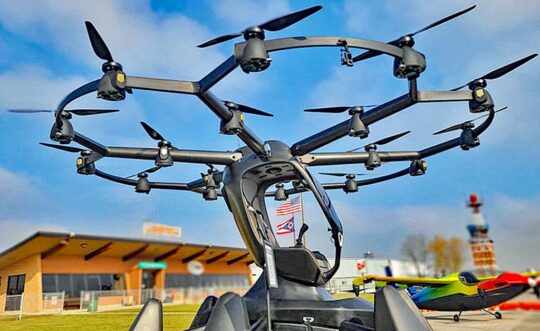
You might get a chance sooner than you think.
Whatever you think right now, would you change your mind if you got to fly one of these machines, safely, of course?
Since autonomous operation is part of the plan, a current-day Lift Aircraft Hexa could take over any time and land safely on its own. Heck, my ancient (3-year-old) DJI drone can do that, with zero input from me. These things are pretty smart. So is a Tesla. The controlling technology is largely here.
So… would you go fly one?
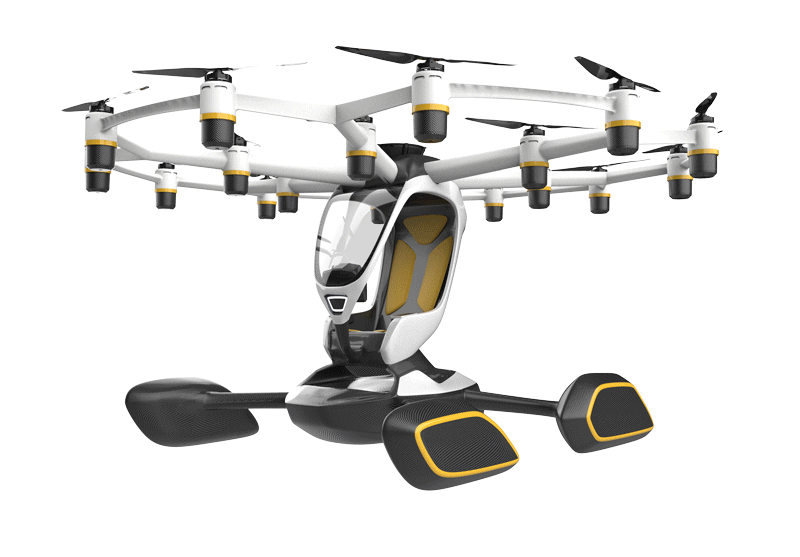
From its base in Austin, Texas, Lift Aircraft has announced big plans. Reviewing their historical performance, it appears this company is capable of advancing rapidly to real-life products. Contrarily, some of these multicopter or swing-wing (Osprey-like) projects promote futuristic Urban Air Mobility (UAM) schemes focused on bringing in millions of dollars, delivering more promise than product.
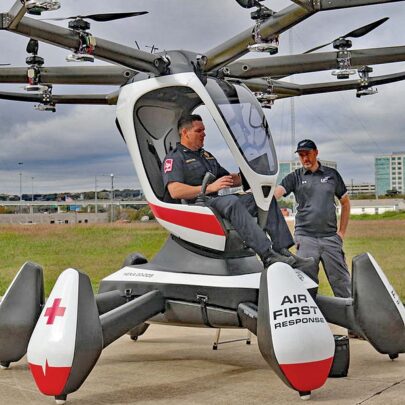
Quick Look-Back…
- In November of 2017 — Lift Aircraft founded.
- December 2017 — Design work underway
- July 2018 in Lago Vista, Texas — First unmanned flight
- October 2018 in Lago Vista, Texas — First manned flight
In less than one year after the company’s founding, Lift Aircraft CEO, Matt Chasen, piloted Hexa on its inaugural manned flight.
“Our team produced a clean-sheet, hover-focused design optimized for safety and conforming to FAR Part 103,” Matt said.
After showing the aircraft at various events, Lift is ready to take Hexa on the road offering 15,000 people who signed up a chance to pilot the aircraft.
“We’re excited to announce that we’re on track to launch customer flights — including our 25-city U.S. Tour — in 2022,” Lift said. “This would make us one of the first eVTOL operators and you, one of the first eVTOL pilots in the world.”
Should You…
Support or Object?
As I wrote this article, I knew sharp-eyed readers might (1) question Hexa’s weight and (2) accept its weight or not, some would lament this could chance unraveling the almost 40-year-old Part 103 regulation.
Now, numerous readers have said for years that the rule needs updating but many others argue that asking for any change might put FAA’s least restrictive regulation at risk.
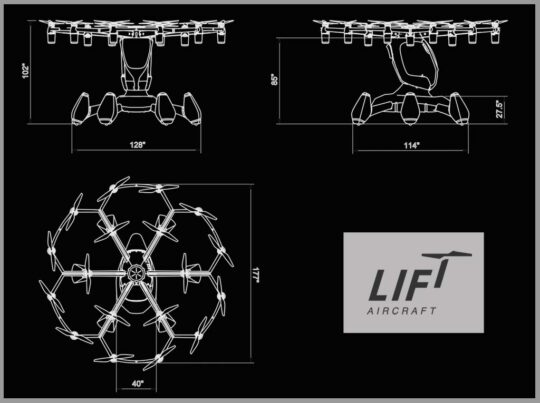
Mosaic, the new regulation expected by the end of 2023, is significantly aimed at accommodating eVTOLs, UAMs, and drones into the airspace. Most readers are focused on how Mosaic affects LSA but multicopters are a major reason why Mosaic exists in the first place. However, the new reg is still two years away.
Therefore, a multicopter that can actually qualify with FAA as a Part 103 vehicle and is (nearly) ready for the market has an early lead.
Slipping into a sweet spot, Lift and their Hexa need not wait for Mosaic, yet will benefit from its arrival.
Here’s how the Part 103 calculations work for Hexa:
- Base empty weight allowance: 254 pounds
- Floats (30 pounds each x 7 floats): 210 pounds
- Ballistic parachute: 24 pounds
- Total allowed: 488 pounds
- Current Hexa empty weight: 432 pounds
- Excess allowance remaining: 56 pounds
Wait! Seven floats? Yes, six on legs and one under the cockpit. Given the 15-foot diameter of the overhead rotor assembly, Hexa needs a wider stance to be stable in the water. This helps Lift on their weight allowances. Does FAA buy it?
Advisory Circular 103-7, issued to guide FAA field offices who evaluate Part 103 Ultralight Vehicles, “has no verbiage that restricts the number of floats,” concluded an FAA MIDO manager when asked specific questions about this aspect of Part 103. FAA may have only envisioned two (larger) floats on a forward landing aircraft but a vertical landing machine requires a different arrangement.
Will “the Public” Fly Hexa?
To reassure pilots and everyone else, Lift has put major attention on safety. “Hexa is semi-autonomous so, regardless of what the pilot does, it will only fly in a safe manner within the limits programmed into the autopilot computer,” notes Lift as they work to bring flying to the public.
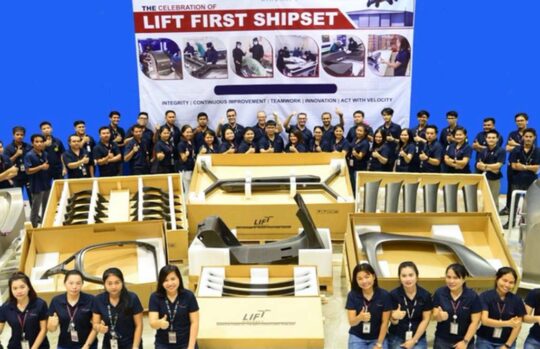
The plans are more explicit in several ways and you can explore their website to learn more.
Does “semi-autonomous” mean you are simply along for the ride? You direct the flight but you (theoretically) cannot screw it up. Is this “cheating?” Are you merely a person saying where you want to fly and the aircraft does it all for you? These are worthy questions pilots may ask.
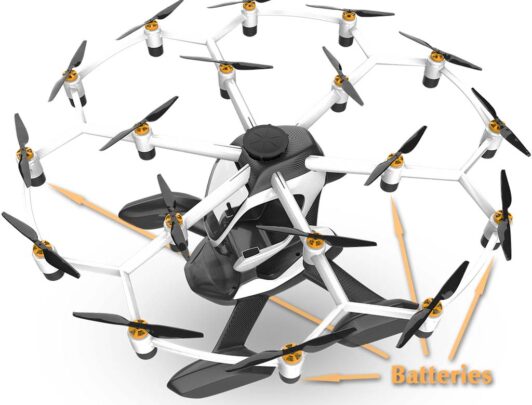
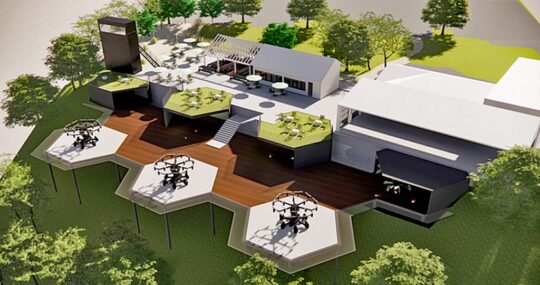
Lift is starting their first Vertiport where people can come fly Hexa, a concept that could make a lot of sense.
Over many years in this business I’ve heard dozens of ideas about how to get more people into aviation. This one sounds as good as any and better than most.
After an hour in their simulator, Lift Aircraft says anyone can go fly, safely. If — that’s a big, giant IF — the software is robust enough, yes, I can believe that.
Would it still be flying as a pilot does today? Well, truthfully, few current pilots might be willing to agree but it could produce better outcomes, that is, less crashes.
This story is just beginning and I’ll circle back if readers show an interest. But here’s an important point.
Lift does not intend to retail sell their Hexa 103 but rather to rent them at a facility they call “Vertiport” (image). The first is already underway but that’s material for another article.
I’ll tell you what — if a Hexa comes my way, I’d love to take it for a flight. Would you?
The following lists highlight some but not all of Lift’s plans. The company seems highly focused on safety. That’s probably good for their corporate future but also good for the future of anyone who flies Hexa.
Could Lift Aircraft set up rental facilities and how would they guard against problems?
- FAR Part 103 allows rental of aircraft
- Redundant 2-way communication with Control (experts guiding a renter’s flight)
- Dedicated controllers monitoring flight telemetry
- Multiple remote pilots on standby
- Assisted preflight and safety briefings
- Emergency assistance and intervention
What happens if a pilot gets in trouble while flying Hexa?
- Flight controlled by computer with joystick input (the pilot does direct the flight, is not just along for the ride)
- “Let go” of stick is a controlled hover
- Automated precision takeoffs and landings
- Automatic low battery Return to Home
- Automatic wind speed, direction adjustments
What are some safety features has Lift incorporated into Hexa?
- Eighteen motors, propellers, and batteries
- Safely land with up to 6 motors disabled
- Highly reliable — only 18 moving parts!
- Propellers out of reach
- Enhanced visibility
- Distributed batteries (away from pilot; located under each motor)
- All critical systems at least 2x redundant
- Design factor of safety — more than 2 everywhere
- 18 separate batteries for fault tolerance
- Batteries located way from pilot (thermal runaway tolerant)
- Safe emergency landing capabilities on water
- Energy-absorbing center float crumple zone
- Whole aircraft air-cushion deploys with low-altitude emergency airframe parachute
First up is Lift’s main promotional video. It depicts an earlier model before the float system was made more capable. Current models have seven floats, six arranged in a circle and one directly under the pilot.
Although this next video appears aimed at those who may want to invest, it also has numerous scenes you may enjoy.



What would be the expected price when launched to the consumer
As the article notes, these aircraft are not presently intended for sale. The plan is to rent them.
The idea of floats to make weight is an interesting idea. Does the FAA have a definition of what a float is? Does a float actually have to keep the aircraft from sinking? Could you put air bladders in wings and call them floats? If you took the tires and wheels off and put them in water they will float, so could I say I have 2 or 3 floats attached that also act as wheels? Could I attach those football tanks that attach to wing struts and label as floats and gain 60 lbs?
The answers to your questions are in AC103-7 (linked in the article). Simple answer: the floats have to demonstrate a purpose, so no to most of your ideas.
FAR 103 works as an amusement park ride over “non-congested” space because there is no commerical usage stipulation in part 103. But amusement park rides are governed by state law. This is a wake-up call to the FAA to start working regulations for UAV air taxi service (assuming the FAA will allow this approach) as technology and innovation advance this concept to introduce vertiport amusement park and potential to increase the scope to intra city travel. Hexa is basically looking at the large UAV (Drone) market for delivery (people and cargo) and not the traditional pilot/aviation market that the FAA regulates.
I fear the FAA lack of regulation foresight will be the road-block for this technology just as it was for the material/structure innovation of the 1960s and 70s that resulted in the collapse of USA soaring industry.
One closing point is that Part 103 has a history of creating bad aviation news press/news events!
Well, Tim, you make quite a few statements in your comment. I’ll offer some commentary.
FAR 103 has nothing to do with amusement park rides. If a vehicle or aircraft flies in the airspace, that’s FAA’s jurisdiction. Lift can rent these aircraft to people and while that has an amusement ride aspect to it, FAA is not giving up oversight on this class. Lift has proceeded on advice from FAA as they laid their plans.
FAA’s regulation-in-process, Mosaic, is significantly aimed at UAVs, UAMs, multicopters, or drones. In fact, including these aircraft in the airspace is a key reason we’re getting Mosaic in the first place.
FAA’s regulation in effect for almost 40 years, the Part 103 rule set, is not governed by Mosaic.
What Lift and their Hexa are planning is not presently related to carrying passengers or cargo.
Your final point really puzzled me. You wrote, “Part 103 has a history of creating bad aviation news press/news events!” If you have a very long memory to the earliest days of Part 103 vehicles, yes, some bad news happened. However, in the last 30 years or more, Part 103 aircraft are hardly ever in the news, so much so that many general aviation pilots have forgotten the category exists. Despite the lack of bad news, Part 103 ultralights are enjoying as much success as they’ve had in a long time.
I have been booked for the intro flight for over a year. I am excited by you guys [at Lift Aircraft]. I am curious about the “floats.” What makes them a “float?” Is it a specific level of positive buoyancy? Are you able to use them to store batteries simultaneously? I assume that added weight has value beyond the float capabilities, and I assume it is a clever way to have increased battery power and stay in the reg. But I am asking to be sure.
I will tell you the batteries are not housed in the floats. As a diagram in the article attempted to show, below each motor is a battery. Beyond that, I hope you can ask your question of Lift Aircraft.
Dan, Part 103 is the very best way for novel experimental flying vehicles to get tested and initial market experience. This is especially true with electric power. Remember, our objective, with the FAA, was to devise a flying machine category with minimal restrictions, one person only and high likelihood of survivability. Lift meets the purposes. Nothing in 103 restricts innovative electronics. All the electronics in the Lift, and many more to come, have derived from our model aviation and multicopter developments.
Personally, I am completing an electric single place motor glider, and it will squeeze into the 103 rigs. First flight later this year.
I will be keen to hear more about your 103 project, Ed!
Love this!
Dan.
Any new update news from the New Zealand Company first test flight of the WAVE they are building?
Ironically, the update on Wave was the article right before the Hexa multicopter one. Here’s a link: Vickers Aircraft Wave Update
If I had the chance I would sign up for a ride in it to check it out , why not?
Any battery powered VTOL will be heavy so don’t count on roof top landings. Where are the pads for landing, other than at the airport? Where is the profit when most of the day they will be on the charger. Most people will be in groups with luggage so there will be a weight problem. Liability will be cost prohibitive. How can they be cheaper than the transportation services already in place? Most things “work on paper” but not this one!
Don, I think you were doing what many have done: assuming that the 103 Lift Hexa is intended to be an air taxi. I’m sure they are headed that direction, but this product is not for that purpose. As I envision their goals, it is to introduce the public to these kinds of aircraft and to build their brand in so doing. If that’s their current game plan, it looks to me like they’re doing things correctly. All that urban air mobility stuff will follow in some years …perhaps.
It will only fly within the limits of the autopilot computer….WOW.
MCAS was supposed to prevent accidents also. Instead it killed hundreds of people.
I hear you, Dale. That’s why I stressed that the software will need to be very robust. Early computers crashed a lot. That’s quite rare now. Perhaps that shows a path along the way toward the future.
Looks good, can’t wait to try one. Do you plan on being in North Carolina in the near future?
You should probably get on the Lift Aircraft list. It’s not certain they will follow up on this comment without your direct request.
Probably long before they venture into Oklahoma where I live. We are who the liberals refer to as “Flyover Country”.
I’m in, 100%!
I would like more info as available.
I urge you to contact Lift Aircraft (links were provided in the article) to get on their email list for information.
Flight duration of 15 minutes. That means a commuter will have to drive “x” amount of time to a vertiport, get checked in, wait for their copter, land at another vertiport, and then hitch an Uber for another “x” minutes of driving to get to their final destination. Until batteries can sustain a much longer flight, it seems to be not very practical.
Your points are well taken, but you are making a common mistake. At this time, the Part 103 Lift Hexa is not intended as an air taxi. It is closer to an amusement ride or something like a artificial-wind-tunnel skydiving experience. The company is surely aimed at the urban air mobility market, but this aircraft is not for that purpose.
Looks really cool. I do not see a purpose for it if it can only be flown at a vertiport and flight time is ridiculous at only 15 minutes fully charged. The company is treating their product more like an amusement park ride than an they are as an aircraft.
You are understanding the concept correctly. If people can come and try these things and have a good, safe experience with them, can you imagine they may be more accepting of a future where air taxis are zipping over their heads regularly? In addition, the company can build their brand while perhaps putting a smile on some faces. I don’t see how that’s a bad thing if done well.
As long as it’s not my investment money, you are correct. Thanks for the interesting stories.